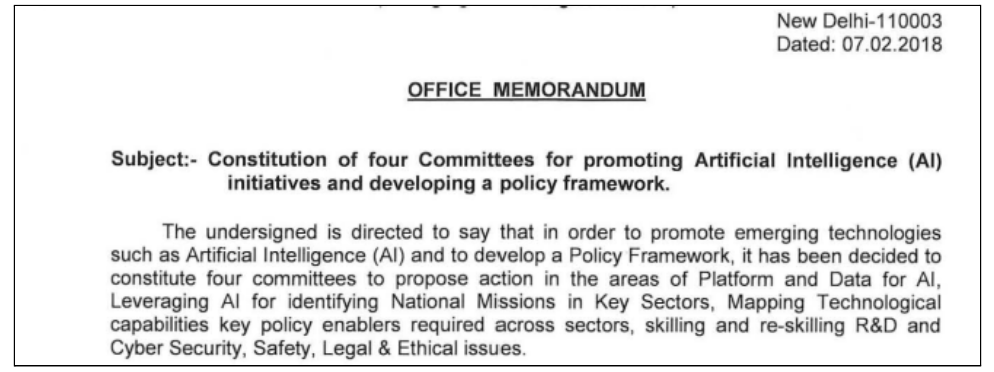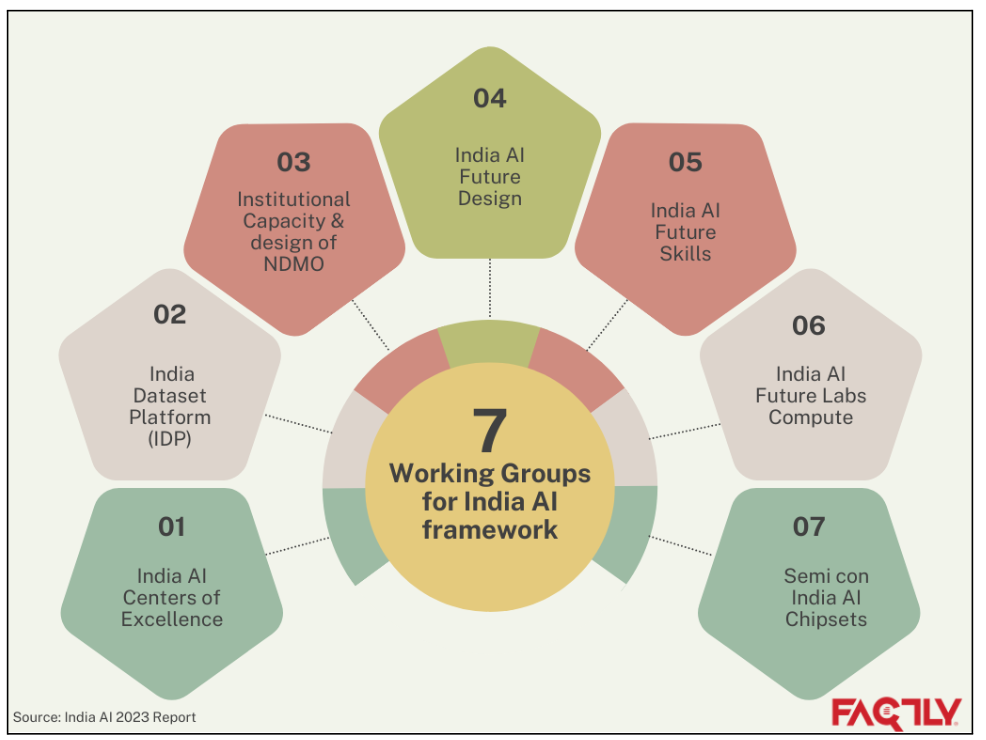The Ministry of Electronics and Information Technology is implementing a ‘National Program on AI.’ The Ministry set up seven working groups, each with focus on different pillars of the India AI framework. The India AI 2023 is a compilation of reports of each of these working groups.
Artificial intelligence (AI) is an exciting and rapidly evolving landscape. It is already transforming various aspects of the present in significant ways, starting from the data analysis and insights for businesses to the healthcare industry in terms of disease diagnosis, and personalized treatment plans. AI is identified to be a ‘kinetic enabler’ in India’s digital economy transition. By 2035, AI is poised to infuse USD 967 billion into the Indian economy, whereas in the nearer horizon, by 2025, AI is forecasted to make a remarkable contribution of USD 450 to 500 billion to India’s GDP, accounting for 10% of the audacious goal of a USD 5 trillion GDP.
Recognising AI’s potential to transform economies and the need for India to strategize its approach, the Finance Minister, in his budget speech for 2018-19, mandated NITI Aayog to establish the National Program on AI, with a view to guiding the research and development in new and emerging technologies. Accordingly, NITI Aayog rolled out the ‘National Strategy for Artificial Intelligence ’, whose aim was to project India among the leaders in the global AI map with a unique brand ‘#AIforALL.’ The Ministry of Electronics and Information Technology (MeitY) has taken measures by implementing a ‘National Program on AI.’ This program encompasses four critical components: the Data Management Office, the National Centre for AI, Skilling in AI, and the promotion of Responsible AI practices. However, recognizing the specific gaps within the AI ecosystem, ‘India AI’ emerges as a vital companion to the ongoing ‘National Program on AI.’ Accordingly, the Ministry set up seven working groups, each with a focus on different pillars of the India AI framework. The India AI 2023 is a compilation of reports of each of these working groups. In today’s story, we look at the key highlights of this report.
India and AI
There has been significant policy activity that has started regarding AI in India. In August 2017, the Ministry of Commerce and Industry established an Artificial Intelligence Task Force with the aim of integrating AI into our economic, political, and legal frameworks, creating a systematic capability to help India become a leading AI-driven economy.
In June 2018, NITI Aayog published the discussion paper for the National Strategy for Artificial Intelligence (NSAI). Subsequently, a thorough analysis of each recommendation is being carried out to create detailed implementation plans, also known as “Approach papers.” The first of these approach papers is AIRAWAT which aims to establish an AI-specific cloud computing infrastructure for India.
Further, recognizing the possible impact of AI on society, the Ministry of Electronics and Information Technology had constituted four Artificial Intelligence Committees.

- Committee A: On Platforms and Data on Artificial Intelligence.
- Committee B; On leveraging AI for identifying national missions in key sectors.
- Committee C: On mapping technological capabilities, key policy enablers for skilling etc.
- Committee D: On cyber security, safety, legal and ethical issues.
The reports were released in July 2019 and were published in December 2019.
Further, on 20 May 2020, the Indian Government introduced the National Artificial Intelligence Portal. This portal will serve as a centralized digital platform for all AI-related developments in India, facilitating the sharing of resources like articles, startups, and investment funds dedicated to AI, organizations, companies, and educational institutions involved in AI within India.
In addition to these activities at the all-India level, state governments are also keen on adopting and levering AI, with states like Karnataka and Telangana investing in the creation of Centres of Excellence.
Brief about the working groups
The Ministry of Electronics and Information Technology set up seven working groups to determine the vision, design, outcomes, and design for each of the India AI pillars. These working groups aimed at building the core goals of the India AI program. Below is a representation of the seven working groups and their study areas.

Key recommendations of the working groups
The seven working groups provided key implementational and operational functionalities for each of their research area. Some of the working groups even provided sample frameworks regarding the same, such as the model curriculum framework for future skilling, sample selection processes for Centres of Excellence and datasets exchange model among others. Some of the major recommendations are as below.

Further, the working group on future lab computing recommended establishing best-in-class AI computing infrastructure at five locations, with a capacity of 3000 AI Petaflops, along with an Inference Farm (2500 AI PF) and Edge Compute (500 AI PF) systems. The working group on Semi Con India AI chipsets recommended assessing the existing infrastructure of chipsets and charting out requirements for technical capabilities, latency, and specifications, detailing the scalability and flexibility of the infrastructure to meet evolving needs and elaborating on the pricing models including applicability, eligibility for a subsidy if any, etc.
Efforts to maximize AI potential laudable, but key issues remain.
AI as a technology holds a lot of promise, and it has both raised aspirations as well as fears. Hence, any blueprint for advancing AI must remain vigilant to the lurking elements in the AI realm that could compromise ethical behaviour, infringe on individual privacy, and weaken security protocols.
Since AI models generate lots of data, and entities might gain an unfair advantage by knowing key insights about the consumers, the utmost important aspect is to have a comprehensive data protection framework with legal backing. The Digital Personal Data Protection Act, 2023 is a step in the right direction even though there are concerns surrounding some provisions.
There could also be a potential weaponization of AI, with cybercriminals using it for malicious purposes. Many of these often involve multiple countries. Accordingly, there is a need to develop cybersecurity techniques and tools that use AI to defend against attacks. Further, fostering international collaboration with a mutual exchange of best practices is a much-needed step to prevent cross-border weaponization of AI.
Additionally, there must be a review of existing laws that may be necessary to adopt AI applications, and the question of the ‘Civil Liability’ of AI must be deliberated as early as possible to prevent any undue damages.
Lastly, as the Committee on cyber security and AI recommended, the Central Government should establish a National Resource Centre for AI in Cyber Security. The Centre may also be designated as the nodal agency for other related issues such as safety, ethical and legal issues.


